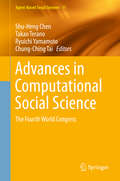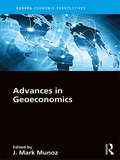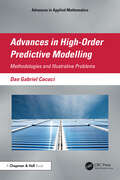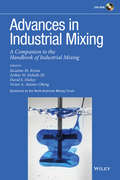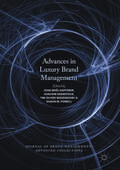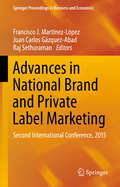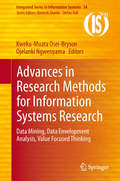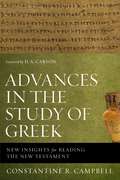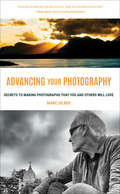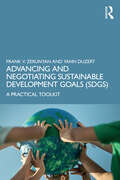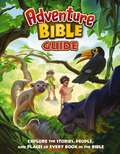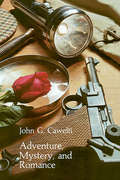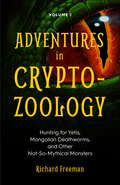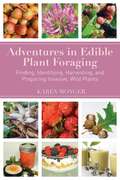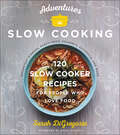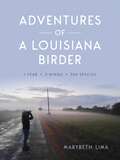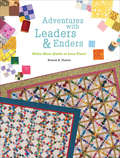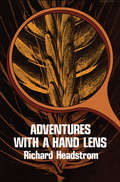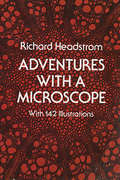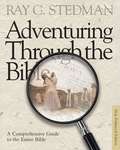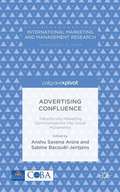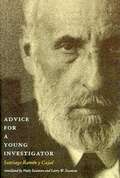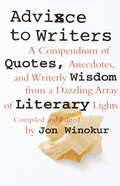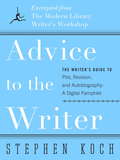- Table View
- List View
Advances in Computational Social Science: The Fourth World Congress (Agent-Based Social Systems #11)
by Takao Terano Ryuichi Yamamoto Shu-Heng Chen Chung-Ching TaiThis volume is a post-conference publication of the 4th World Congress on Social Simulation (WCSS), with contents selected from among the 80 papers originally presented at the conference. WCSS is a biennial event, jointly organized by three scientific communities in computational social science, namely, the Pacific-Asian Association for Agent-Based Approach in Social Systems Sciences (PAAA), the European Social Simulation Association (ESSA), and the Computational Social Science Society of the Americas (CSSSA). It is, therefore, currently the most prominent conference in the area of agent-based social simulation. The papers selected for this volume give a holistic view of the current development of social simulation, indicating the directions for future research and creating an important archival document and milestone in the history of computational social science. Specifically, the papers included here cover substantial progress in artificial financial markets, macroeconomic forecasting, supply chain management, bank networks, social networks, urban planning, social norms and group formation, cross-cultural studies, political party competition, voting behavior, computational demography, computational anthropology, evolution of languages, public health and epidemics, AIDS, security and terrorism, methodological and epistemological issues, empirical-based agent-based modeling, modeling of experimental social science, gaming simulation, cognitive agents, and participatory simulation. Furthermore, pioneering studies in some new research areas, such as the theoretical foundations of social simulation and categorical social science, also are included in the volume.
Advances in Geoeconomics (Europa Economic Perspectives)
by J Mark MunozWhile geopolitics has captured global attention, geoeconomics is the often hidden force that governs countries’ relationships. It is the economic psyche that shapes the new world order. Geoeconomics refers to the intersection of economic factors, relationships and conditions on global events. A country’s political and business alignments have an impact on individuals, companies and on future economic stability. This book assembles leading scholars and experts from around the world to advance current thinking on geoeconomics. It is a thorough and authoritative reference work on world economics that aims to shape strategy formulation in business and government for years to come by expanding understanding on the topic of geoeconomics, analyzing the implications of international geoeconomic events, and providing the reader with theoretical and practical approaches on the management of geoeconomics. Geoeconomic concepts in this book will prove timely and highly insightful to students, academics, executives, entrepreneurs, government officials, consultants and policymakers.
Advances in High-Order Predictive Modeling: Methodologies and Illustrative Problems (Advances in Applied Mathematics)
by Dan Gabriel CacuciContinuing the author’s previous work on modeling, this book presents the most recent advances in high-order predictive modeling. The author begins with the mathematical framework of the 2nd-BERRU-PM methodology, an acronym that designates the “second-order best-estimate with reduced uncertainties (2nd-BERRU) predictive modeling (PM).” The 2nd-BERRU-PM methodology is fundamentally anchored in physics-based principles stemming from thermodynamics (maximum entropy principle) and information theory, being formulated in the most inclusive possible phase-space, namely the combined phase-space of computed and measured parameters and responses.The 2nd-BERRU-PM methodology provides second-order output (means and variances) but can incorporate, as input, arbitrarily high-order sensitivities of responses with respect to model parameters, as well as arbitrarily high-order moments of the initial distribution of uncertain model parameters, in order to predict best-estimate mean values for the model responses (i.e., results of interest) and calibrated model parameters, along with reduced predicted variances and covariances for these predicted responses and parameters.
Advances in Industrial Mixing
by North American Mixing Forum Arthur W. Etchells III David S. Dickey Suzanne M. Kresta Victor A. Atiemo-ObengAdvances in Industrial Mixing is a companion volume and update to the Handbook of Industrial Mixing. The second volume fills in gaps for a number of industries that were not covered in the first edition. Significant changes in five of the fundamental areas are covered in entirely updated or new chapters. The original text is provided as a searchable pdf file on the accompanying USB. This book explains industrial mixers and mixing problems clearly and concisely. Gives practical insights by the top professionals in the field, combining industrial design standards with fundamental insight. Details applications in 14 key industries. Six of these are new since the first edition. Provides the professional with information he/she did not receive in school. Five completely rewritten chapters on mixing fundamentals where significant advances have happened since the first edition and seven concise update chapters which summarize critical technical information.
Advances in Luxury Brand Management (Journal of Brand Management: Advanced Collections)
by Jean-Noël Kapferer Joachim Kernstock Shaun M. Powell Tim Oliver BrexendorfPresenting some of the most significant research on the modern understanding of luxury, this edited collection of articles from the Journal of Brand Management explores the complex relationships consumers tie with luxury, and the unique characteristics of luxury brand management. Covering the segmentation of luxury consumers worldwide, the specificity of luxury management, the role of sustainability for luxury brands and major insights from a customer point of view, Advances in Luxury Brand Management is essential reading for upper level students as well as scholars and discerning practitioners.
Advances in National Brand and Private Label Marketing: Second International Conference, 2015 (Springer Proceedings in Business and Economics)
by Francisco J. Martínez-López Juan Carlos Gázquez-Abad Raj SethuramanThis book presents the latest research and recent studies in the field of national brand and private label marketing. It covers a wide range of topics, including retailing, marketing, general business, psychology, economics and statistics. It addresses diverse areas of application, such as brand naming and packaging decisions, price elasticity, positioning, branding, consumer motivation, online communities, economic crisis, strategies in growth and mature private labels. The contributions are organized according to the following themes: consumer behaviour, strategic decisions, branding, market trends and theoretical research. The book presents a collection of original, rigorous and relevant contributions from the 2015 National Brands and Private Label Marketing conference in Barcelona.
Advances in Research Methods for Information Systems Research: Data Mining, Data Envelopment Analysis, Value Focused Thinking (Integrated Series in Information Systems #34)
by Kweku-Muata Osei-Bryson Ojelanki NgwenyamaAdvances in social science research methodologies and data analytic methods are changing the way research in information systems is conducted. New developments in statistical software technologies for data mining (DM) such as regression splines or decision tree induction can be used to assist researchers in systematic post-positivist theory testing and development. Established management science techniques like data envelopment analysis (DEA), and value focused thinking (VFT) can be used in combination with traditional statistical analysis and data mining techniques to more effectively explore behavioral questions in information systems research. As adoption and use of these research methods expand, there is growing need for a resource book to assist doctoral students and advanced researchers in understanding their potential to contribute to a broad range of research problems. Advances in Research Methods for Information Systems Research: Data Mining, Data Envelopment Analysis, Value Focused Thinking focuses on bridging and unifying these three different methodologies in order to bring them together in a unified volume for the information systems community. This book serves as a resource that provides overviews on each method, as well as applications on how they can be employed to address IS research problems. Its goal is to help researchers in their continuous efforts to set the pace for having an appropriate interplay between behavioral research and design science.
Advances in the Study of Greek: New Insights for Reading the New Testament
by D. A. Carson Constantine R. CampbellAdvances in the Study of Greek offers an introduction to issues of interest in the current world of Greek scholarship. Those within Greek scholarship will welcome this book as a tool that puts students, pastors, professors, and commentators firmly in touch with what is going on in Greek studies. Those outside Greek scholarship will warmly receive Advances in the Study of Greek as a resource to get themselves up to speed in Greek studies. Free of technical linguistic jargon, the scholarship contained within is highly accessible to outsiders.Advances in the Study of Greek provides an accessible introduction for students, pastors, professors, and commentators to understand the current issues of interest in this period of paradigm shift.
Advancing Your Photography: Secrets to Making Photographs that You and Others Will Love
by Marc SilberThe author of Create presents &“an all-in-one, easily accessible handbook . . . [that] will show you how the pros do it. Study this and take your best shot&” (Chase Jarvis, award-winning photographer). In Advancing Your Photography, Marc Silber provides the definitive handbook that will take you through the entire process of becoming an accomplished photographer. From teaching you the basics to exploring the stages of the full &“cycle of photography,&” Silber makes it easy for you to master the art form and create stunning pictures. From thousands of hours of interviews with professional photography masters, you will learn valuable insights and tips on beginner, amateur, landscape, wedding, lifestyle, sports, animal, portrait, still life, and iPhone photography. Advancing Your Photography features: · Top tips for making outstanding photographs from iconic photographers and many other leading professional photography masters of today · Numerous step-by-step examples · Guidance on training your eye to see composition with emotional impact · Tips on mastering the key points of operating your camera like a pro · Secrets to processing your images to professional standards Photography and the technology associated with it are constantly evolving, but the fundamentals remain the same. Advancing Your Photography will help to bring you the joy and satisfaction of a lifetime of pursuing the art of photography.
Advancing and Negotiating Sustainable Development Goals (SDGs): A Practical Toolkit
by Frank V. Zerunyan Yann DuzertAdvancing and Negotiating Sustainable Development Goals (SDGs) presents a negotiation framework based on the principles of network/collaborative governance in implementing UN Sustainable Development Goals (SDGs). Trialed in the classroom and workplace, the practical toolkit gives you the tools necessary for facilitating future collaboration and knowledge transfer to all those working to strengthen the formulation, implementation, and achievement of SDG-oriented policies. Advancing and Negotiating Sustainable Development Goals (SDGs) is essential reading for those interested in a better and more sustainable future for all.
Adventure Bible Guide: Explore the Stories, People, and Places of Every Book in the Bible (Adventure Bible)
by ZondervanExplore the Bible like never before! This companion to the bestselling Adventure Bible gives young readers the key details of every book of the Bible at their fingertips. With kid-friendly overviews of Genesis through Revelation and full-color infographics, maps, and images, children will strengthen their faith and gain a deeper understanding of the most important story ever told.The Adventure Bible Guide takes readers 8–12 on a fun-filled, informative journey toward truly understanding God&’s Word. This immersive reference guide gives clear, crisp insights into the Bible book by book, including:key details and events that are clearly laid out, in words kids can easily understandcolorful infographics that include historical information, significant events and details, and important biblical characterscallouts with fun facts and key takeawaysmaps that help readers understand where each part of the Bible occurredimages of artifacts and important places that help bring the Bible to lifeThis book is made to be used alongside the Bible to help readers better comprehend the context and background of God&’s Word, condensing the most important information in a highly visual, easy-to-understand format, which in turn helps kids connect with the Bible text in new and deeper ways.The Adventure Bible Guide is:perfect for kids 8–12 learning to explore the Bible on their owna great resource for teachers, parents, and homeschoolers to use to engage students in the Bible and biblical historypart of the wider Adventure Bible line, which includes NIV Adventure Bible, Adventure Bible Book of Devotions,?and The Adventure Bible Book of Daring Deeds and Epic Creations
Adventure, Mystery, and Romance: Formula Stories As Art And Popular Culture
by John G. CaweltIn this first general theory for the analysis of popular literary formulas, John G. Cawelti reveals the artistry that underlies the best in formulaic literature. Cawelti discusses such seemingly diverse works as Mario Puzo's The Godfather, Dorothy Sayers's The Nine Tailors, and Owen Wister's The Virginian in the light of his hypotheses about the cultural function of formula literature. He describes the most important artistic characteristics of popular formula stories and the differences between this literature and that commonly labeled "high" or "serious" literature. He also defines the archetypal patterns of adventure, mystery, romance, melodrama, and fantasy, and offers a tentative account of their basis in human psychology.
Adventures in Cryptozoology Volume 1: Hunting for Yetis, Mongolian Deathworms, and Other Not-So-Mythical Monsters (Adventures In Cryptozoology Ser.)
by Richard FreemanDiscover the history and science behind these (not so) imaginary creatures—and how to search for them yourself. Cryptozoology, the study of hidden, monstrous, and legendary animals, is truly the art of discovering the unknown. Richard Freeman, Zoological Director of Centre for Fortean Zoology, has explored the corners of the five continents in search of creatures that many people believe are non-existent. In this book, he shares the exciting stories of his investigations of the Yeti, Mongolian Deathworm, Loch Ness Monster, Orang-Pendak, Ninki-Naka, and more. Cryptozoologists throughout the years have studied unknown species of reptiles, lake and sea creatures, apes, and hominins. The science and history of this field of study includes examples of creatures that were once thought to be mythological, but that have since been proven to exist. If you&’re ready to begin your search for Sasquatch and learn to hunt monsters, Adventures in Cryptozoology is your guide. In these pages you&’ll find: · Tales of mythical, extinct, and out-of-place creatures · Hints about Bigfoot and other ape-men · And tips for equipping your own cryptozoology adventure, including all the gear, field craft, and resources you&’ll need to record your findings
Adventures in Edible Plant Foraging: Finding, Identifying, Harvesting, and Preparing Native and Invasive Wild Plants
by Karen MongerPurchasing vegetables and leafy greens can become rather pricy. Moreover store-bought greens often contain unhealthy pesticides and chemicals that can be harmful to your health. Foraging for wild plants is a cost effective and healthy alternative. Harvested wild plants are cheaper, and much healthier with a significantly higher nutritional value than what you typically purchase in grocery stores contain. On top of that, harvesting your own plants will force you to get out, exercise, and explore the great outdoors, which is an excellent way to stay fit and spend time with your family. Written with novice foragers in mind, Adventures in Edible Plant Foraging, serves as a simplified guide to edible plants that can be found throughout North America, and includes a glossary of botanical terms. This all encompassing guide will teach you how to prepare for your first foray into foraging--what to bring and what to watch out for--and show you how to identify various edible wild plants native to your own backyard, the forest, fields and the sandy shores along lakes and beaches. With over 90 full color photographs and 20 recipes for soups, salads, muffins, desserts, and more, this book is a must have for anyone looking to save money and begin their first expedition into foraging.
Adventures in Slow Cooking: 120 Slow Cooker Recipes for People Who Love Food
by Sarah DiGregorio“An exciting and refreshingly unbiased guide to slow cooking . . . even die-hard fans of these appliances will learn something new.” —Library Journal, starred reviewSarah DiGregorio, a James Beard nominated food writer, has reinvented slow cooking for a generation that cooks for fun and flavor, taking a fresh approach to reclaim this versatile tool without sacrificing quality or taste.Showcasing a beautiful, engaging design, inviting color photographs, and 105 original, innovative recipes thoroughly tested in a variety of brands of slow cookers, Adventures in Slow Cooking provides a repertoire of delicious food. Inside you’ll find ideas for flavorful sweet and savory slow cooker dishes, including:Whipped Feta, Red Pepper and Olive DipGranola with Pistachios, Coconut and CardamomSavory Overnight Oatmeal with Bacon, Scallions and CheddarTurkey-Spinach Meatballs Stuffed with MozzarellaSpicy Kimchi and Pork RamenOrange, Olive and Fennel Chicken TagineDaal with Mango and Mustard SeedsFarro Bowl with Smoked Salmon, Yogurt, and Everything-Bagel SpiceOxtail and Short Rib PhoCorn, Mushroom and Zucchini TamalesProper Red Sauce Eggplant ParmPeach-Orange Blossom JamMatcha-White Chocolate Pots de CrèmeCardamom-Molasses Apple Upside-Down CakeStar Anise-Black Pepper Hot ToddySarah also provides tips and tricks that will help cooks get the most out of today’s slow cookers. With a foreword by Grant Achatz, modernist chef and advocate of the slow cooker, Adventures in Slow Cooking makes this convenient appliance an indispensable tool for the modern kitchen.“DiGregorio has made the slow cooking downright sophisticated.” —Epicurious “Fun and useful. . . . DiGregorio uses a multistep approach to help build flavor in the slow cooker . . . a must-have for slow-cooker fans.” —Publishers Weekly
Adventures of a Louisiana Birder: One Year, Two Wings, Three Hundred Species
by Marybeth LimaThis candid and humorous chronicle shows how one woman goes from casual observer to obsessive bird nerd as she traverses Louisiana’s avian paradise. In Adventures of a Louisiana Birder, readers follow Marybeth Lima across her adopted state in search of 300 species of birds. Bisected by the Mississippi flyway and home to 400 miles of coast, Louisiana has a variety of habitats, which serve as a beautiful backdrop to this remarkable journey. In birding circles, some devotees attempt what is known as a “big year,” a bird-sighting challenge to identify as many bird species as possible in a particular geographical area over the course of one year. Lima’s initial effort amounted to 11,626 miles in sixty-one road trips to log an impressive 280 species. But on a subsequent quest to exceed her record, she endures elusive birds, embarrassing misidentifications, and hungry insects in an effort to reach her goal. In the midst of these obstacles, Lima celebrates the camaraderie and friendly competition among fellow birders, from novices to a world-renown ornithologist. Requiring both mental focus and physical agility, birdwatching becomes an active sport through Lima’s narration. She vividly conveys the elation over a rare species seen or heard and the disappointment when one is narrowly missed. An appendix provides the location and date of every species she identifies. Lima’s personal experiences are interwoven with the excitement of tracking down one intriguing species after another. She faces a near-fatal burn accident to her spouse, end-of-life care for her mother-in-law, and Louisiana’s great flood of 2016. In the midst of these situations, her devotion to birding provides a much-needed outlet. “Somewhere in the roiling confluence of birds, locales, and human personalities,” writes Lima, “the center of my heart sings with utter abandon.” Adventures of a Louisiana Birder is the author’s call to a deeper passion for and awareness of Louisiana’s unique natural beauty and vulnerability.
Adventures with Leaders & Enders: Make More Quilts in Less Time!
by Bonnie K. HunterAn easy method to faster quilt-making, and incredible patterns to make use of your scrap stash. What if you could piece quilts even faster, work on more than one quilt simultaneously and save money, fabric and thread all at the same time? Bonnie K. Hunter will show you how to put the concept of Leaders & Enders to work quickly and easily, expanding your creativity, and upping your productivity all at the same time. If you have ever found yourself paralyzed by your stash, overwhelmed by scraps you just can't bear to toss out, arm yourself with a new rotary blade for your cutter, make yourself a cup of tea and start reading. This book is not only full of beautiful scrap quilts that can be made in between the lines of other sewing, but also contains many ideas for getting your ever burgeoning scrap stash under control, into useable sized pieces that work well with one another, and ready to be sewn into quilts you've always wanted to make. Bonnie K. Hunter has done it again!
Adventures with a Hand Lens
by Richard HeadstromWith an ordinary magnifying glass and this book as your guide, 50 adventures in close observation await you. These entertaining nature studies take you on field trips in and around your home, calling attention to interesting features of dozens of familiar or overlooked plants, insects, and other animals, and common materials like cloth, quartz, and the paper on which this book is printed.A great deal of basic natural-science theory and detail is presented in this delightful narrative. Flowers and grasses, fish scales, moth and insect wings, egg cases, buds, feathers, seeds, leaf scars, moss, molds, ferns, and common crystals are among the many structures examined, often comparatively. Many natural processes and behavior patterns are observed -- seed dispersal and other methods of reproduction, protective coloration, rusting symbiosis, fertilization of the soil, breathing and case building of insects, and many others, all with only an inexpensive hand lens as equipment and with "specimens" you probably pass by going for a walk. More than 200 labeled illustrations accompany the text.The author is a former teacher and associate curator of the New England Museum of Natural History. No previous science background is assumed of readers, and curious readers of almost any age will find this book an interesting introduction to numerous facets of nature study.
Adventures with a Microscope
by Richard HeadstromWith a simple microscope and this book, you can embark on 59 wonderful adventures in the natural world -- make discoveries about the structures of numerous microscopic animals; find out what everyday objects and foods really look like at the cellular level; gain an understanding of how to prepare specimens and slides; and learn about many scientific phenomena such as how a fly can walk upside down on the ceiling. It's all here in simple-to-understand language and 142 clear line drawings.The author first examines under the microscope such everyday objects as a human hair, air bubble, scale of a herring, poppy seed and sugar crystal, and then offers through-the-microscope views of such creatures and objects as the water flea, hydra, house fly, amoeba, euglena, volvox, diatoms, desmids, algae, blood corpuscles, honey bee, rotifer, water-mites, potato starch, and other food substances, lichen, paramecium, coffee, sponge, chalk, yeast, bacteria, mustard, pepper, bryozoan, moss, mushroom, molds, cotton, and other textile fibers, ferns, dragon-flies, flea, spider, roots, and other plant structures, paper, aphid, fingerprints, nervous system of the grasshopper, and more.Richard Headstrom, formerly associated with the New England Museum of Natural History and an experienced teacher and writer on natural science for young people, has made this book simple enough for any beginner at home as well as interesting for more experienced students and lay readers. Enjoyable and instructive, these adventures with a microscope will appeal to all who are curious about what there is to see beyond the range of the naked eye.
Adventuring Through The Bible: A Comprehensive Guide to the Entire Bible
by Ray C. StedmanUnderstanding the Bible can be somewhat intimidating for laypersons. However, the new and improved edition of Adventuring Through the Bible is designed to give readers a thorough overview of the entire Bible in an easy and exciting way. Features more than 1,000 pages filled with outlines, themes, and applications to help the reader grasp the message of each book of the Bible. Provides the reader with a one-stop guide for studying and understanding God's Word.
Advertising Confluence: Transitioning Marketing Communications into Social Movements
by Anshu Saxena Arora Sabine Bacouël-JentjensAdvertising Confluence offers a unique blend of both traditional and contemporary social media thinking about advertising and integrated brand promotions from both the developed and emerging world.
Advice for a Young Investigator
by Neely Swanson Larry W. Swanson Santiago Ramón y CajalSantiago Ramón y Cajal was a mythic figure in science. Hailed as the father of modern anatomy and neurobiology, he was largely responsible for the modern conception of the brain. His groundbreaking works were New Ideas on the Structure of the Nervous System and Histology of the Nervous System in Man and Vertebrates. In addition to leaving a legacy of unparalleled scientific research, Cajal sought to educate the novice scientist about how science was done and how he thought it should be done. This recently rediscovered classic, first published in 1897, is an anecdotal guide for the perplexed new investigator as well as a refreshing resource for the old pro. Cajal was a pragmatist, aware of the pitfalls of being too idealistic -- and he had a sense of humor, particularly evident in his diagnoses of various stereotypes of eccentric scientists. The book covers everything from valuable personality traits for an investigator to social factors conducive to scientific work.
Advice to Writers: A Compendium of Quotes, Anecdotes, and Writerly Wisdom from a Dazzling Array of Literary Lights
by Jon WinokurJon Winokur, author of the bestselling The Portable Curmudgeon, gathers the counsel of more than four hundred celebrated authors in a treasury on the world of writing. Here are literary lions on everything from the passive voice to promotion and publicity: James Baldwin on the practiced illusion of effortless prose, Isaac Asimov on the despotic tendencies of editors, John Cheever on the perils of drink, Ivan Turgenev on matrimony and the Muse. Here, too, are the secrets behind the sleight-of-hand practiced by artists from Aristotle to Rita Mae Brown. Sagacious, inspiring, and entertaining, Advice to Writers is an essential volume for the writer in every reader.
Advice to the Writer
by Stephen KochFrom Stephen Koch, former chair of Columbia University's graduate creative writing program, comes essential and practical advice drawn from The Modern Library Writer's Workshop. With nearly thirty years of teaching experience, Stephen Koch has earned a reputation as an astute and benevolent mentor; and with Advice to the Writer, his lucid observations and commonsense techniques have never been more accessible. Here Koch dispenses sound guidance for those moments when the muse needs a little help finding her way: in "Shaping the Story," he untangles plot; in "Working and Reworking," he explains the most teachable (yet least often taught) of all writerly skills: revision; and in "The Story of the Self," he delves into autobiography. Featuring handpicked commentary from some of our greatest authors, Advice to the Writer is a unique introduction to this maddening and intoxicating pursuit. Praise for Stephen Koch's The Modern Library Writer's Workshop "An extraordinarily comprehensive and practical work by a master craftsman and a master analyst of the craft."--Madison Smartt Bell, author of All Souls' Rising and Anything Goes "Stephen Koch was my teacher long ago. Now he is everyone's teacher, indelibly. This is a book not just for the beginning writer but for every writer."--Martha McPhee, author of the National Book Award nominee Gorgeous Lies "The Modern Library Writer's Workshop is a treasure trove of wisdom, both immensely practical and philosophical, entertaining and thought-provoking. Koch takes us inside the writing process, and it is impossible not to emerge transformed."--Joanna Hershon, author of Swimming
Advisory Circular AC 43.13-1B With Change 1 AC 43.13-2B
by U.S. Department of Transportation Federal Aviation AdministrationThe "bible" for AMTs, aircraft owners, and homebuilders, this FAA Advisory Circular outlines the standards for acceptable methods, techniques, and practices for the inspection, repair and alteration of non-pressurized areas of civil aircraft with a gross weight of 12,500 lbs or less. Includes both Part 1B and Part 2B. This edition contains: AC 43.13-1B Acceptable Methods, Techniques, and Practices: Aircraft Inspection and Repair, with Change 1 (effective September 2001) AC 43.13-2B Acceptable Methods, Techniques, and Practices: Aircraft Alterations (effective March 2008). Note that AC 43.13-2B can now be used as approved data.
